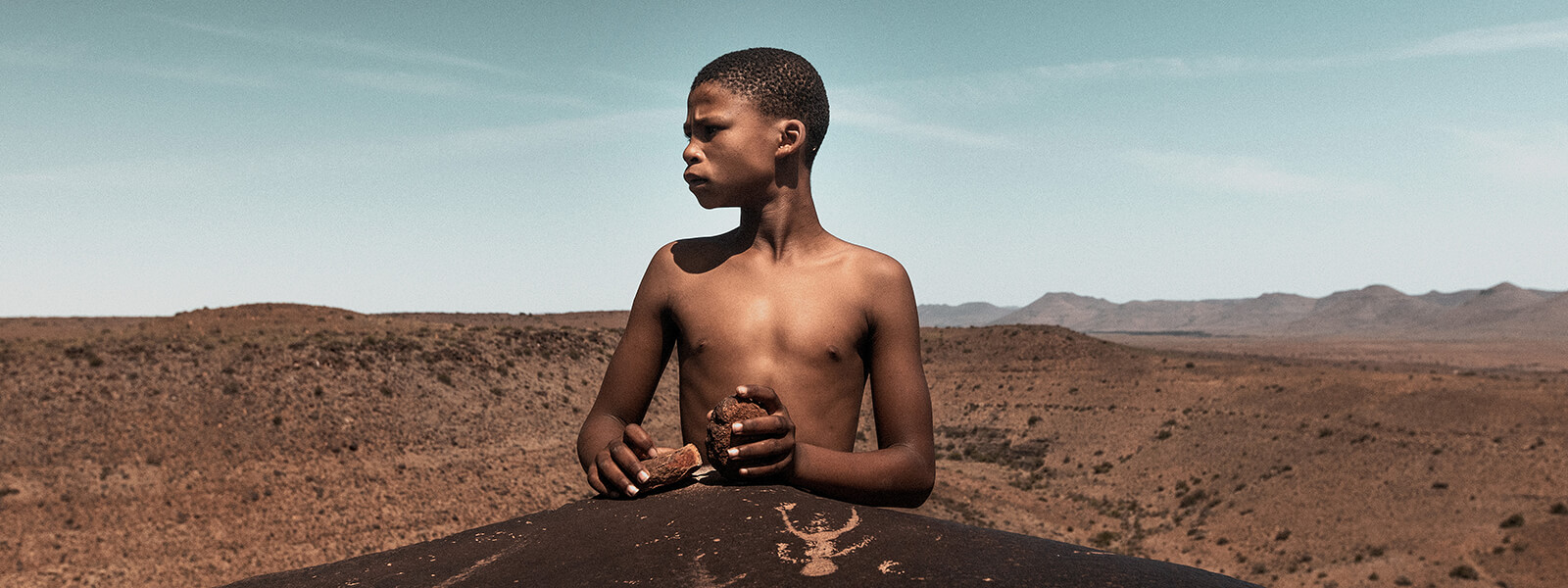Something remarkable is happening in a remote part of South Africa’s Northern Cape province, in a semi-desert area called the Karoo. In the past 15 years, 64 radio-receiving dishes have appeared on the landscape. These constitute the MeerKAT telescope, a precursor to the Square Kilometre Array Observatory (SKAO), which will – when it is completed and fully functional in 2030 – be the world’s largest radio telescope.
The SKAO will receive signals emanating from the dark regions between the stars and galaxies. This data, studied by radio astronomers, can inform us about dark matter and could change our conception of the universe irrevocably.
In his new, award-winning documentary,!Aitsa, filmmaker Dane Dodds explores the intellectual background and science of the SKAO alongside indigenous conceptions of the cosmos held by ancient ǀXam San people and their Afrikaans-speaking descendants living in the Karoo today. As the film’s advisor, I saw my task as bringing into focus the hidden assumptions that must be recognised in any encounter between knowledge, traditions and cosmology.
!Aitsa (a South African exclamation of praise or surprise) explores the SKAO’s approach to understanding the universe through big data made comprehensible by the techniques of empirical science, machine learning, artificial intelligence and instrumentation. The film also examines Karoo star lore as it is shared and spread by an interwoven tapestry of oral traditions. Conventional ideas about the nature of science are challenged and the dominant structures of knowledge creation are questioned as a result.
To the ǀXam and San people, being in the world as a person includes “the sky’s things” – an understanding of and deep connection with the cosmos. In an age progressively dominated by digital and automated knowledge, the film needed to hold space for this notion.
Inflected with star-lore
Through my research in the fields of archaeoacoustics, rock art and oral tradition I have come to understand that there is a profound multiplicity of connections within the ǀXam knowledge tradition. In a ǀXam conception of the universe, there is no alienating distance between inner and outer, person, stars and space. That’s because their cultural understanding of reciprocities encourages ecological and cosmic connection.
!Aitsa strives to express astronomy as a lived-body experience. One person interviewed in the film says:
"When I look up into the sky and look at how my star is positioned, and look up at the star’s direction, I know which way to walk." Another describes the Milky Way as being “right at the centre of a person’s spirituality.”
Animism and animation
The instruments of modern science deliver facts, innovation and technical advancement. But all this comes with societal entanglements and colonial dynamics, a part of the intellectual history of scientific endeavour that assumes authority and stands aloof from the kinds of sensory perceptions and lived experience that are central to ǀXam San cosmology.
!Aitsa investigates a modern pre-disposition that considers animistic knowledge and reasoning as inherently flawed. Animism is the notion that any living thing has a distinct spiritual essence. It’s a mistake to dismiss ǀXam cultural expression as a mythology that is intrinsically animistic and therefore quaint.
The ǀXam and San people are known as “the people of the eland” and so, to illustrate the way their beliefs animate “things”, an eland antelope is a key character in !Aitsa. The animal’s presence compels the viewer to consider the importance of relationship and relatedness.

Soundscapes
Sound plays a crucial role in the film, and was another opportunity to showcase an element of |Xam San culture. The soundtrack (you can hear a preview here) draws on composer Simon Kohler’s musical creativity and the archaeoacoustic research I have done on lithophones, otherwise known as gong rocks, which produce sounds not dissimilar to that of a bell when it is struck.
Sound is the most ephemeral and transitory of presences but in the film, the gong rock sound is a thread linking voices and images, past and present. Collecting the sound required two trips into the Karoo. There we recorded a variety of rock sounds – deep bass vibrations through to light metallic tinkles. We brought these recordings back into the Cape Town sound studio where the sound was “composed” to create the soundtrack that viewers will hear throughout the film.
 Production still of!Aitsa showing the Square Kilometre Array Observatory (SKAO)
Production still of!Aitsa showing the Square Kilometre Array Observatory (SKAO)
What next?
!Aitsa had its world premiere at CPH: DOX in Denmark in 2023, with sold-out screenings and rave reviews. The film won the Grand Prize at Estonia’s Pärnu International Film Festival and was voted Best of the Fest at the Encounters Film Festival in Cape Town. !Aitsa is selected to screen in Canada at Planetinfocus and in October 2023 at the Prague Science Film Fest and is up for selection at the idfa Festival in the Netherlands in November.
In 2024, !Aitsa will go on a road trip, visiting remote places in the Karoo where the film will be screened to audiences who do not have the means for or access to cinemas.
We also hope to take the film to Australia so that the Wajarri Yamaji Aboriginal people can see, listen and connect with their counterparts in the Karoo. This is an important connection because the Wajarri Yamaji live in the Murchison region in Western Australia where the low-frequency component of the SKAO is currently under construction. DM
This story was first published on The Conversation. Neil Rusch is a Research Associate at the University of the Witwatersrand.




 Production still of !Aitsa showing the Square Kilometre Array Observatory (SKAO)
Production still of !Aitsa showing the Square Kilometre Array Observatory (SKAO)